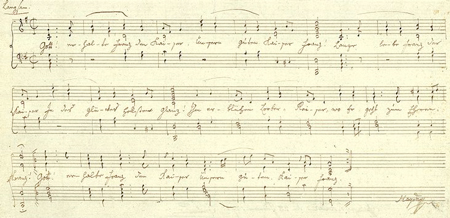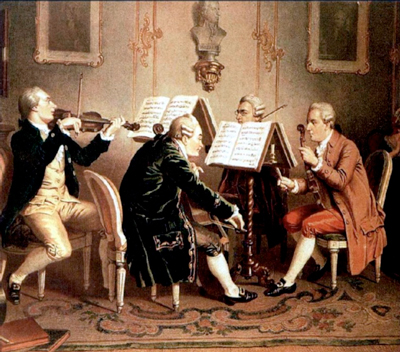by Neil McCalmont
Part of McCalmont’s List Series

Scoring: 2 violins, viola, and cello
Era: Classical
Length: c. 20 minutes
Will you recognize it? Probably not — but the 2nd-movement theme did become Germany’s national anthem during the Nazi Era. It also became a Protestant Hymn titled “Austria.”
Recommended Recordings: Gewandhaus-Quartett or the Amadeus Quartet
Composer: Joseph Haydn (1732-1809) (pronounced hide-in). For generations, Haydn has been looked upon as the grand old man of music and is often referred to as the “Father of the String Quartet” as well as the symphony. One of the most versatile and prolific composers of his time, Haydn also wrote oratorios that are considered among his masterworks. He was an important teacher of Beethoven and an equally important friend and supporter of Mozart.
For 30 years, Haydn worked almost exclusively for his patron, Prince Nikolaus Esterházy. The composer achieved fame throughout Europe and traveled as a musical celebrity during his old age. Haydn’s constant popularity can be attributed to his use of easily discernible forms, innovative thematic development, and catchy melodies. Much of his music is also known for its wit.
The Piece: The “Emperor” String Quartet is the third of his final six string quartets, which are often described as the finest string quartets from the 18th century. This quartet epitomizes the Classical style since its themes are based on two-, four-, or eight-bar phrases. Like many of his other instrumental compositions, it is structured in four movements and follows the format that Haydn largely developed — an upbeat allegro (fast), an adagio (slow) that is often a theme and variations, a minuet and trio (a dance), and a presto (fast and lively). This would become the norm for the next hundred years or so.
The “Emperor” Quartet is full of distinctive Haydn character. The first movement’s opening theme boasts many subtle twists and turns and a marvelous bounce. The second movement is a set of variations based on the composer’s anthem “God Save Emperor Francis,” named for the ruler of the Austrian Empire at the time. The melody is a bit of an earworm — good luck getting it out of your head! This movement in particular allows the instrumentalists to showcase their virtuosity. The minuet and trio is one of Haydn’s finest. It dances gracefully but also creates dramatic tension to keep things interesting. The finale begins intensely — almost brashly. Its high energy keeps you on the edge of your seat.
Personal Notes: You can count on Haydn’s music to be filled with cheerfulness and hummable tunes. It can also make it easy to zone out and let the music wash over you. While there is no problem with this, Haydn’s music truly shines in its subtleties. Behind this pleasant, seemingly simplistic music lies the craftsmanship and artistic instincts of a genius.
Fun Facts:
- The anthem in the second movement was one of Haydn’s favorite compositions. Even during his sickly and delicate old age, he still managed to get to the piano, at times only to play that theme.
- The anthem was also used in other compositions by important composers, including Beethoven, Schubert, Rossini, and Tchaikovsky.
- Haydn’s musical sense of humor is legendary. Listen to the first minute of the second movement of the “Surprise” Symphony (No. 94) or the final movement of his “Joke” String Quartet, Op. 33, No. 2.
- After Haydn’s funeral, two graverobbers bribed the gravedigger to give them Haydn’s head, which he eventually did. Eleven years later, Haydn’s body was moved, and the movers were furious to find his skull missing. The graverobbers were hunted down, but returned a fake skull rather than the real one. The descendants of the Esterházys eventually got the skull back in 1954. However, the previous skull was not removed, so Haydn’s tomb now contains two skulls.
Further Listening:
- The other five Op. 76 string quartets by Haydn
- The 12 “London” Symphonies by Haydn
- Piano Concerto No. 21 in C by Wolfgang Amadeus Mozart
- “Trout” Quintet by Franz Schubert
Why couldn’t Beethoven find his music teacher?
…
…
Because he was Haydn!
Published on ClevelandClassical.com July 29, 2016.
Click here for a printable copy of this article





